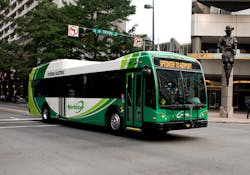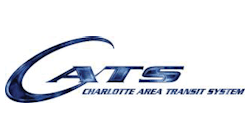The Charlotte Area Transit System (CATS) operates a Sprinter airport enhanced bus route. During the APTA 2016 Bus and Paratransit conference, CATS invited conference-goers to experience the line. Sprinter runs from downtown to the Charlotte Douglas International Airport in around 28 minutes. With Five buses running in 20-minute intervals on weekdays and 30-minute intervals on weekends, from 7 a.m. to 7 p.m. — the Sprinter line features 17 bus stops in each direction. The five buses are hybrid-electric Gillig vehicles, aimed at providing better air quality for the city.
Jason Lawrence, senior transportation planner for CATS, said originally there were 40 stops before they cut it down to 17. “What we wanted to do is once we got the stops in, we wanted people to treat it differently than other routes.”
Lawrence emphasized that the key part of the Sprinter was that the line was based on creating a new brand. The buses have no exterior advertising to keep with that brand idea as well. The route was designed primarily aimed toward ridership of airport workers and businessmen who were going back and forth from the airport and downtown. With that ridership in mind, stops targeted large business areas, hotels and the culinary school.
“We have been somewhat flexible to where we located or moved stops — but it has to be for a good reason,” said Lawrence.
Some stops were relocated due to low frequency — only having one or two riders — so there wasn’t a lot of push back from the community.
The Sprinter’s bus stop shelters are designed to be unique and minimalistic. Ordnances prevented them from doing any advertising at the structures so they went in another direction. Tolar Manufacturing created the unique minimalistic structures — created out of etched glass — imaging on the structures were picked to honor Charlotte. Drawn from local history in the particular area along each stop, including soldiers near a WWI site or spools of thread near an old textile factory. The stops on the opposite side of the street have the same image, but one side with the negative and the other with the positive, which was also cost saving.
“It threads the story of the community,” explained Lawrence.
North Carolina Department of Transportation (NCDOT) required that all structures — including kiosks with live-time arrival information — needed to be breakaway. Putting in the actual stops was more difficult than anticipated. There were also strict regulations requiring that bus stops had to be near existing signalized intersections (on the far side if feasible), it needed to connect to a sidewalk network, have available power supply, needed to be away from driveways and far enough away from the road to fall within NCDOT clear zone requirements.
“We were able to negotiate with them in some spots — in some spots it just wasn’t possible to meet all requirements,” explained Lawrence.
Current developments for the Sprinter airport enhanced bus include a new stop. Goodwill Industries is in the process of building a large training facility and outreach center, attracting other businesses to the same shopping center.
Lawrence said that some of the lessons they learned during the process came from how they originally went about planning the route. “We treated each side of the route as individual projects. It took too long.”






